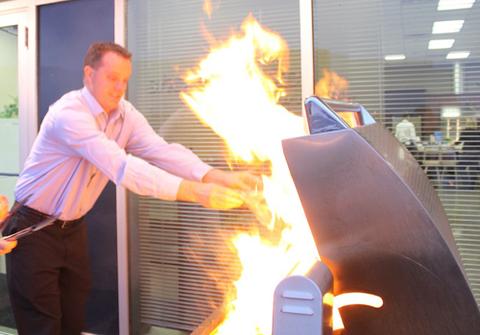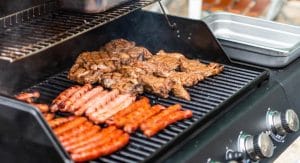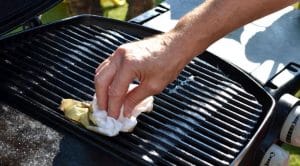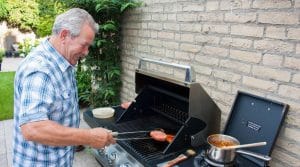How to Prevent Grill Flare Ups
Here is a short video courtesy of My recipes
Imagine this: it’s a nice warm night, and you’re enjoying it by putting some steaks on the grill. Everything’s going well, and you’re excited to get inside and enjoy your steaks with some potatoes and maybe a nice cold brew. What could be better?
But then, in the blink of an eye, flames are shooting out of your grill. Your steaks are turning darker by the moment, just like your vision of the night is falling apart by the moment. You’re experiencing a grill flare-up, a common but pesky and dangerous type of grill fire.
Luckily, grill flare-ups are preventable. You can prevent grill flare-ups in a number of ways, like choosing to grill lean meats, trimming the fat of the meat, using oil sparingly, wiping down your catch pan, preheating your grill, cleaning and brushing your grates, opening your lid, grilling away from the wind, and not overcrowding your food on the grill.
To make sure your perfect night grilling steaks doesn’t get interrupted by a grill flare-up, we’ve researched all the best ways to prevent grill flare-ups. And to make sure you’re a pro on the subject, we’ll walk you through what grill flare-ups actually are, how to know you’re experiencing one, how to prevent them, and how to control them in the event it does happen.
Grill Flare-Ups and How to Prevent Them
In order to prevent grill flare-ups, it’s helpful to know a few other key things, like what grill flare-ups actually are, how to tell if you’re experiencing one, and the different types of grills that are prone to grill flare-ups. You’ll be a (safe) grill master in no time!
What Are Grill Flare-Ups?
Perhaps one of the most important things to know in preventing grill flare-ups is what grill flare-ups actually are. Grill flare-ups happen for a number of reasons that we’ll get into later, but ultimately, grill flare-ups are a burst of intense, high flames on a grill.
Grill flare-ups usually start when a piece or pieces of fat drip from the food on the grill down to the coals. As the fat collects, the coals on the grill flare-up, turn into tall flames and eventually grow taller and larger.
Grill flare-ups are especially common when grilling meats. Grilling meats with more fats can make grill flare-ups even more common. Flare-ups can, of course, come in different sizes depending on if any preparation has been done to prevent them and if one knows how to control them.
While smaller flare-ups aren’t a huge danger to you, your grill, or your food, consistent flare-ups can be a cause for concern. Consistent grill flare-ups can actually burn the exterior of your food, ultimately making it drier and crispier (and probably not what you envisioned when you started grilling).
Flare-ups often happen when grilling meats, especially fatty ones. This is because of what can drip off of the meat and onto the coals or the gas burner; excess fat, oil, marinades, and sauces can all drip off the meat and start a flare-up.
An unclean grill or built up grease and carbon on the grill are also large causes of flare ups. If there is already grease and other substances that have dripped on the grill, it’s much easier for those to ignite and cause a flare up.
Fire and oxygen are best friends, but they’re not your best friends – especially when you’re grilling! Grilling when it’s windy can allow for more oxygen to sneak into your grill, therefore causing flare ups.
A very high temperature inside the grill can also cause flare ups. It’s important to monitor the temperature when grilling. The temperature of the grill may be higher when the grill lid is closed.
If you’re grilling with the lid of your grill closed, you may also be putting your grill at bigger risk to flare ups. Grilling with the lid closed creates more heat, and can, therefore, create a flare up. However, sometimes it’s not possible to grill certain types of meat with the lid open. Exercise caution and good judgment!
How to Know You’re Experiencing a Grill Flare Up
While it seems like you should be able to know when you’re experiencing a grill flare up, you may not actually notice until it’s too late. Knowing the characteristics of grill flare ups can help you identify them, prevent them, and ultimately control them if they happen to break out.
Here are some ways to know if you’re experiencing a grill flare up:
- You may be experiencing a grill flare up if flames accumulate on your grill and spread Flare ups happen and spread fast.
- Grill flare ups may still continue to rage even if you remove the food from the grill. With flare ups, the flames may not die down even if you remove the food, close the gas, and turn off the grill.
- Grill flare ups are also characterized by tall, high flames with a large amount of smoke. The flames and smoke may also be accompanied by black soot.
The Different Types of Grills
There may be different techniques for preventing and controlling grill flare ups depending on the type of grill you have. So, it’s important to know about the types of grills that may be prone to flare ups.
There are two types of grills in which grill flare ups tend to happen: gas grills and charcoal grills. Knowing about these grill types is important later on when we discuss how to control a grill flare up if it happens. Below is a brief overview of the two grill types.
Gas Grills
Gas grills are great because you can simply turn off the gas and (hopefully) prevent and control flare ups. However, gas grills are at risk of flare ups for that same reason. With gas grills, it’s easy to turn off the gas on the grill, take off your food, shut the lid, and forget about any grease or other substances that have collected on the grill. That can cause a flare up the next time around.
Charcoal Grills
Charcoal grills use coals to cook the food being grilled. Since you technically can’t just turn charcoal grills off, flare ups can spread easily when substances leak onto the coals, and they can be a little more difficult to put out.
How to Prevent Grill Flare Ups
Now that you know all the basics and the background stuff, like what grill flare ups are, what causes grill flare ups, the characteristics of grill flare ups, and the different types of grills that can be prone to grill flare ups, we can get to the real “meat:” how to prevent grill flare ups.
Sure, grill flare ups can happen, but grill flare ups are preventable! Knowing how to prevent grill flare ups can lessen their effects and even stop them from happening entirely. Keep yourself, your grill, and your tasty food safe by using these tips to prevent grill flare ups.
Practice the “Safe-Zone Method” or the “Two-Zone Method”
These methods are extremely useful and popular when it comes to preventing grill flare ups. The “Safe-Zone” and the “Two-Zone” methods are essentially interchangeable names for the same method.
These methods simply mean adding coals to one side of the grill but leaving the other side of the grill free of coals. This creates two zones, or one “Safe-Zone,” where the food can be moved to should a flare up happen.
It’s smart to use the “Safe-Zone” or “Two-Zone” method no matter what when you’re grilling. Imagine if a flare up happened and you didn’t have a “Safe-Zone” for your food on the other side of the grill. You’d likely have to go grab a plate, pan or platter from your kitchen (if you didn’t already have one out), take your food from the grill and put it on the plate, and then return your food once the flare up died down.
Flare ups happen and build quickly, so time is of the essence with them. Being able to quickly move your food to the cool “Safe” side of the grill is much quicker, much safer, and can help flare ups die down more quickly.
Make Sure Your Grill is Clean
A clean grill means less accumulated grease, which means fewer chances of flare ups. Chances are you know how to clean your grill, but in case you don’t, you’ll need some supplies. To get your grill to a basic, good clean, you’ll need:
- A wire brush
- Soap and water
- Regular (non-soapy water)
- A bucket or two (or something to hold your soapy and regular water in)
You’ll need to clean a few different parts of your grill, like the grates and the catch pan. Follow these steps to ensure your grill is clean and at its best:
- Fill a bucket with warm, soapy water
- Get your wire brush
- If you’ve got a gas grill, disconnect your gas line
- Remove the grates of your grill
- Brush your grate down with the wire brush
- Apply some soapy water to the grates
- Rinse the grates down with some regular water when finished
- If you’ve got a charcoal grill, brush out the insides of your grill (then move to step 12)
- Remove the barrier that separates the grates from the burner shield
- Unclog the burner holes and brush away anything around them
- If your grill has a flame shield as the barrier, wipe it down with the warm soapy water and rinse with some regular water. Then replace it
- Use a wire brush to brush down the insides of the grill and use the soapy water to scrub it down. Rinse everything with normal water and dry it with a cloth.
- Preheat your grill for at least 10 minutes before beginning to grill again
Try to Choose Lean Meats to Grill With
You probably know by this point that flare ups are often caused by grease, fat and other substances dripping from your food. So, naturally, one of the ways to prevent flare ups is to try to choose food to grill that’s lean and has less fats and grease.
For example, if you’re grilling steaks, try choosing cuts that are leaner and have less fats, like sirloin or Filet mignon. If you’re grilling hamburgers, try to get ground beef that says its 90% lean. Being a little more mindful at the grocery store can help you prevent those flare ups.
Trim the Fat off Your Meats as Best You Can
If you’re grilling meats that aren’t super lean or are fatty, try to trim the fat of the meat as best as you can. Chances are, some lean meats still have fat too, and you may also want to trim the fat from them.
Use a cutting board and a sharp knife to cut away excess fat before putting your meat on the grill. That way, you may prevent a flare up altogether or prevent a flare up from being large. The typical trimming tip is to cut all the fat from the edges but ¼ inch before grilling. Less fat and oils that can drip equals a lesser chance of a flare up.
Use Oils, Marinades and Sauces Sparingly
When it comes to grilling, we all know that some marinades, oils, and sauces are what really make the food amazing. Nobody wants you to completely cut back on using oils, marinades or sauces, but when it comes to flare ups, the less of them the better.
To prevent grill flare ups, use a “less is more” approach with marinades, oils, and sauces on food on the grill. Use a brush to apply a thin layer of your choice to your food or grill grate. If it’s not dripping when you put it on, that’s a good sign you’ve used it sparingly.
Remember, you can always add more sauces, marinades, and oils once you’re done grilling. If it prevents you from experiencing a grill flare up and prevents your food from being charred, why not? Safety first! Sorry, sauces, oils, and marinades- the grill might not be the best place for you.
Make Sure Not to Overcrowd Your Food on the Grill
Overcrowded food on the grill can be a recipe for a grill flare up. It’s also a recipe for disaster if a grill flare up does happen – you won’t be able to move your food anywhere on the grill to get away from the flare up.
This tip goes hand in hand with the “Safe-Zone” and “Two-Zone” methods. If you’ve got a “Safe-Zone” on your grill, you can easily move the food to that zone when a flare up happens. If you don’t have a “Safe-Zone” or room to move your food in the event of a grill flare up, your food is more prone to being charred and burned. It’ll also be much harder to control a grill flare up and get it to go out.
Grill Away from the Wind
Previously we talked about how the wind can cause grill flare ups. Like we said, fire and oxygen are friends, but when it comes to grill flare ups, they aren’t your friends. Remember that!
No, you can’t really control the weather. However, you can control where you grill! Try to grill in an area that’s at least somewhat protected from the wind. Front and back porches are typically great for this when the wind is abundant. Avoiding the wind as best as you can is a great way to prevent grill flare ups.
Open the Lid of Your Grill
Like we also mentioned before, grilling with the lid closed creates more heat inside the grill, therefore creating a higher risk of a grill flare up. A simple solution to possible grill flare ups is to grill your foods with the lid of the grill open.
Consider what you’re grilling though; grilling with an open lid may not cook thick meats as thoroughly or as well. Use caution, and always keep an eye on your grill. If you need to close the lid of your grill for whatever reason, make sure you’re paying attention to it.
Preheat Your Grill Before Using
Preheating your grill before throwing food on it is another great way to prevent possible grill flare ups. When you preheat your grill before using it, excess debris is typically burned off. That way, it can’t start a flare up.
Before putting your food on the grill, preheat your grill, get the excess debris off, and lessen your chances of a grill flare up.
How to Control a Grill Flare Up if it Happens
Knowing how to prevent grill flare ups is extremely important and can help you avoid them. However, grill flare ups are still pretty common, and even if they’re just small, they can still happen. So, what can you do if a grill flare up does happen? How can you control it and get it to go out?
The ways to control a grill flare up may depend on the type of grill you have. Follow these tips for what to do should you encounter a grill flare up.
Controlling a Grill Flare Up on a Gas Grill
When grill flare ups happen, gas grills are typically easier to control than charcoal grills. If a grill flare up appears on your gas grill, you’ll want to follow a few steps.
- Turn off your burners using the knobs. Your knobs may be hot! If they’re too hot to grab, use a pair of tongs or an oven mitt (whatever you’ve got closest to you) to turn them off.
- Grab baking soda, sand or salt to smother the fire once the gas is turned off. Use whichever of the three you’ve got available.
- Close the lid and close the vents on the grill. This prevents more oxygen from moving in.
- Wait 30 seconds. If the grill flare up is still raging and even popping out of the vents, you’ll need to use a fire extinguisher.
Controlling Grill Flare Ups on a Charcoal Grill
Controlling grill flare ups on a charcoal grill can be a little different and even trickier than controlling grill flare ups on gas grills. With charcoal grills, creating a “Safe-Zone” or using the “Safe-Zone” and “Two-Zone” methods are extremely important.
There are a few things you’ll need to do first to prevent flare ups on a charcoal grill and to control flare ups when they happen.
Build a Fire of the Right Size
Chances are, you don’t need a ton of briquettes when grilling on your charcoal grill. You don’t need an extremely large or hot fire! Try to estimate how long you’ll be cooking and how much you plan on cooking.
Remember to use your “Safe-Zone” or “Two-Zone” method and use coals on one side of the grill. You can also use coals on the right and left side of the grill, but keep the middle empty so you still have a “Safe Zone.”
That way, if grill flare ups happen, you can move your food to the “Safe-Zone” and wait for the flare up to go out. It helps if you’ve built a fire of the right size and not gone too crazy with the amount of briquettes.
Use the Spray Bottle Method
This method is a little controversial, as, well… oil and water don’t mix. However, it’s been known to work with charcoal grills and controlling flare ups. Keep a spray bottle full of clean water next to your grill area.
If a flare up happens, you can move your food to the “Safe Zone” and spray down the flames that are coming from the coals underneath with the spray bottle. You can also spray directly under the food without moving it if you wish. Exercise caution with this tip! If the water is making the grill flare up worse, stop using it.
Cover and Wait
If you haven’t created a “Safe Zone” on your grill, or a flare up has started and turned into very large flames, you may want to use the cover and wait method. With this method, first remove all the food from the grill.
Next, cover the grill and close the vents. Wait a few minutes to see if the flare up has died down. You can do this by looking in the vents rather than opening the cover; the cover may not be safe to open.
If you’ve looked in the vents and it looks like the flare up has died down a bit, slowly open the lid of your grill a few inches. Make sure to keep your body and face away from the cover as you do so. If you don’t get any flames or flashback, you can open your grill cover completely, and if you feel it’s safe, you can return your food to the grill.
What NOT to Do When Grilling or When Grill Flare Ups Happen
So far we’ve walked you through everything you can do to prevent grill flare ups and to control grill flare ups when they happen. But what about the flip side? There’s got to be some things NOT to do when you’re grilling to prevent flare ups or some things NOT to do when flare up happens.
There are some things you’ll definitely want to avoid when grilling or when grill flare ups happen. Let’s take a look at a few of them.
- Don’t poke your food or meats to see if they’re done. This pushes juices and oils out of the meat, which can more easily lead to a grill flare up.
- Don’t press on your food or meat with a spatula when grilling. This also pushes juices and oils out of the meat, which leads to grill flare ups!
- Don’t constantly flip your meats on the grill. You probably guessed it, but this also pushes out oils and juices and can fuel a flare up.
- Never try to move a grill that’s a victim to a flare up, or even a grease fire. While your first thought may be to get your grill (and the flames) away from your home or other surfaces, you’ll put yourself at great risk of injury and harm trying to move the grill. You’re also putting your grill at greater risk for tipping and spreading the flames, which can be even worse!
- Don’t try to put out large flames with water. That’s a bad idea! While you can use a spray bottle to control small flames below the grate’s surface, if you have large flames spewing from the grill – never use water to extinguish it.




